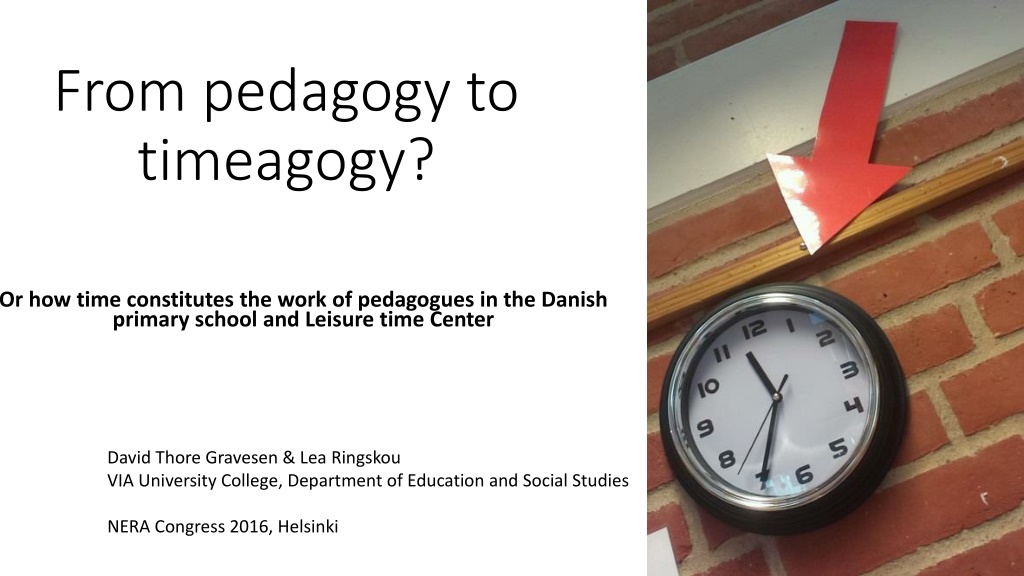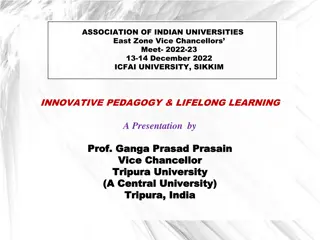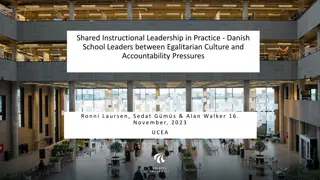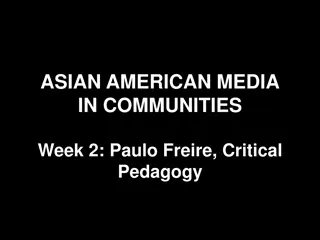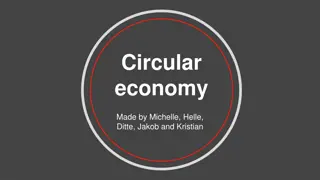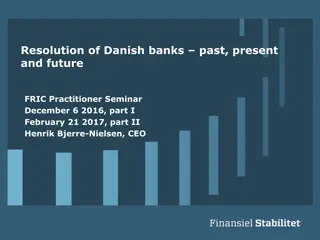Timeagogy in Danish Primary School Pedagogy: Impact of Time on Pedagogues' Work
Exploring the shift from pedagogy to timeagogy in Danish primary schools, this study investigates how time shapes the work of pedagogues post-reform. It delves into the emotional consequences of changes and the dominance of time as a driving force in pedagogical practices. By focusing on time management and leadership within time structures, the study reveals the concept of timeagogy and its micro and macro dimensions.
Uploaded on Sep 19, 2024 | 0 Views
Download Presentation

Please find below an Image/Link to download the presentation.
The content on the website is provided AS IS for your information and personal use only. It may not be sold, licensed, or shared on other websites without obtaining consent from the author. Download presentation by click this link. If you encounter any issues during the download, it is possible that the publisher has removed the file from their server.
E N D
Presentation Transcript
From pedagogy to timeagogy? Or how time constitutes the work of pedagogues in the Danish primary school and Leisure time Center David Thore Gravesen & Lea Ringskou VIA University College, Department of Education and Social Studies NERA Congress 2016, Helsinki
Background Background The reform in 2014 Rationale and intentions behind the reform Impact on the everyday practice of leisure-time pedagogues
Research Research interests interests The professional routines of the leisure time pedagogues in the Danish Primary School after the reform in 2014. How, and to what extend, have the reform affected daily practices? & The emotional consequences of the reform: how do the pedagogues feel about the changes, and how do these feelings affect their work?
Methodological approach Methodological approach Two Danish Primary Schools Data collecting methods Ethnographic participant observations Qualitative semi-structured focus group interviews Diaries Dialogue seminars
Conclusions Conclusions The dominance of time Timeagogy as a category to describe the accelerated and transformed pedagogy. From pedagogy (leading, supporting and controlling the children) to a practice we name timeagogy, focusing more on the leadership of time, controlling and managing that individuals adhere to the logics and imperatives of time structures. Time becomes an object in it s own right Timeagogy: micro dimensions and macro dimensions
Time in Time in sociological sociological literature literature intensification of nervous stimulation which results from the swift and uninterrupted change of outer and inner stimuli (Simmel, 1969: 48) The techniques of rationality have ceaselessly distanced us from what we've taken as the advent of an objective world: the rapid tour, the accelerated transport of people, signs or things, reproduce - by aggravating them - the effects of picnolepsy, since they provoke a perpetually repeated hijacking of the subject from any spatial-temporal context (Virilio 2009, 110).
()more and more activities pressed into the same amount of time: they have to eat faster in the cafeteria, may have only three minutes to change classrooms, and after-school life is often regimented by fast-paced schedules (Szollos 2009, 333) Time itself becomes an object, and when a certain sense of time is internalized and becomes invisible, natural and obvious, it can get a life of its own, that is seldom problematized and scrutinized (Frykman & L fgren 1979)
Empirical examples: - The haste of things - The construction of rhythm - The training
The haste of things We walk to the forest. Susan leads. The children are walking in pairs in a long row. Susan brings a whistle and instructs the children, telling them what to do, when she blows the whistle. ( ) Karen and Peter team up and walk together. Later Susan instructs the children on how to write their names with materials they find in the forest. ( ) After some time working with the assignment, the children play more freely. Seemingly, Peter did not solve the task. Susan announces it is time to walk back to the school. Karen responds impulsively: We barely had the time to get here, now we have to go back!
The construction of rhythm Numerous children are frustrated because some of the tasks are unfamiliar to them. Loudly a boy says that he has no eraser. Several classmates offer their eraser, including Paula. "It was kind of you Paula" Joan says across the class. "I already got one" the boy answers. Shortly after Joan heads to Paula. You must wait for Inga she says, you do not know if it's the right word ... it's great you can do it, but you must wait for Inga!
Joan: The days are just too long, and for many, there are way too many shifts In the morning they have one teacher, then another, then a third, then on to this, then on to that. Throughout the day, shifts, shifts, shifts! All the time they have to move on to something new Simply, I think many of them do not benefit from those long days and the many shifts.
But an attempt is also made to assure the quality of the time used: constant supervision, the pressure of supervisors, the elimination of anything that might disturb or distract; it is a question of constituting a totally useful time.(Foucault 1977, p. 150) According to Foucault, the disciplinary time establishes rhythms, imposes particular occupations and regulates the cycles of repetition (ibid., 149)
The training The quiet shifts The artefacts: I only do it on days like this , she excuses, when explaining why she uses the whistle. The training of schoolchildren was to be carried out in the same way: few words, no explanation, a total silence interrupted only by signals - bells, clapping of hands, gestures, a mere glance from the teacher (Foucault 1977, 166)
Timeagogy and emotions Timeagogy and emotions Emotional labor and feeling rules induce or suppress feeling in order to sustain the outward countenance that produces the proper state of mind in others (Hochschild 1983, p. 7). Emotional ambivalence Well, I think that some of them [the politicians and political advisors], who s sitting there, measuring things, the wise ones at Christiansborg [headquarter of the Danish Government] they don t know, what they re talking about. ( ) You just can t work that way, when working with relations making it effective how does it affect the relation?
Surface acting: It s a condition in my job. As long as I have the upper hand, most often things work out fine. If I m not in control, some of the children will notice and react. Tomorrow in math, I must be strong and reestablish their confidence.
Coldness and cynicism ( ) it started this year, I was so close to saying: I can t do this anymore that I could no longer be a part of this, because I couldn t do it satisfactorily and I couldn t sleep at night ( ) and then I had to realize that now you re at work and when you leave, you clock out! So I ve just gotten colder ( ) I feel much colder in my relation to the children than ever before.
The The logics logics of of timeagogy timeagogy Time as an object in its own right - internalized, invisible and natural (Frykman & L fgren 1979) The dominance of time in school and leisure time centers functions as part of a bio-political regulation mechanism (Foucault 1977) Focus on better results and academic qualification overshadows other important elements of schooling and leisure time, such as processes of socialization and subjectification (Biesta, 2010)
The practices and emotions within timeagogy is in risk of being individualized the pedagogues carrying the weight of the world on their shoulders (Bourdieu, et al., 1999) do I react negatively towards them?... do I have a wrong attitude towards them? do I make the call a little too fast?
Thank Thank you you! ! References: Biesta, G. (2010). Good education in an age of measurement. Paradigm. Bourdieu, P., Accardo, A., Balazs, G., Beaud, S., Bonvin, F., Bourdieu, E., . . . Wacquant, L. J. (1999). The Weight of the world - social suffering in contemporary society. Polity Press. Foucault, M. (1977). Discipline and Punish. Penguin Books. Frykman, J., & L fgren, O. (1979). den kultiverade m nniskan. Glerups Utbildning AB. Hochschild, A. R. (1983). The Managed Heart. London : University fo California Press. Simmel, G. (1969). The Metropolis and Mental Life. I R. Sennet, Classic essays on the culture of cities. New York: Prentice Hall. Szollos, A. (2009). Toward a psychology of chronic time pressure. Time and Society, no. 2/3, s. 332-350. Virilio, P. (2009). the Aesthetics of Dissaperance. Semiotext(e).
